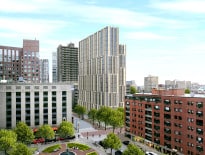Satellite health and urgent care centers, specialty centers, diagnostic suites – look around during your next commute and you’re certain to notice the uprising of these in-city and suburban facilities.
Take a closer look still and you may notice that these hospital/health care organizations have hired a private sector developer not only to design the off-site facility but also to manage the financing and construction side of the project.
This trend is growing and with good reason. The health care industry recognizes the importance of population health and the innate advantages to helping patients avoid hospitalization. Off-campus facilities are cropping up rapidly to deliver care in highly populated regions. In contrast to the merger and acquisition heydays of the 1980s and 1990s, many health care systems today have re-routed their focus on specialty and urgent care centers.
Two reasons for this change are the emergence of independent national care providers focusing on one care area such as the urgent care market, and the shift in how people approach their health care. Most people are now educated consumers of health care, no longer simple patients seeking guidance and treatment.
Enter private sector developers, whose responsibility to design and oversee management of the financing and construction of these off-site facilities allows hospital administrators to focus more on the health care side of the coin, rather than the real estate end. Private sector developers become the landlord once a site location is agreed upon and the facility is constructed, eliminating that layer of responsibility from the hospital. (Tax benefits to the healthcare organization may also be realized based on this approach.)
Introducing Care Into Communities
Presently, hospitals are taking a two-track approach to reducing patient treatment within the hospital and into communities. The rise of urgent care centers speaks to the need and desire to reduce hospital emergency room volume – track one. The second burgeoning health care footprint is in the growing creation of ambulatory surgical centers, where outpatient day procedures are performed. As with urgent care centers, the ambulatory surgical facilities make way for traditional hospital surgical departments to deal with more inpatient volume.
These treatment, diagnostic and surgical facilities must be highly efficient in design and management to meet financial targets. In the case of ambulatory surgical centers, the reimbursement for procedures is far less than if the surgery was performed in a hospital setting, so the volume and turn over in surgeries must be constant and at a high volume. The imperative is to place exceedingly efficient surgeons in this environment to allow for high-volume performance. This approach also allows hospital operating rooms to focus on more complicated, lengthier inpatient surgeries.
One of the largest types of off-campus facilities on the rise are oncology centers. Chemotherapy is mostly performed on an outpatient basis, with some cancer centers embracing the spa trend in the healthcare environment by offering a serene ambiance, in contrast to the rush-rush atmosphere of a traditional hospital. And private developers, whose business it is to know how to design for comfort and cost efficiency, can have an eye toward sustainable practices in these center; for example, integrating ample daylight where appropriate and focusing on energy savings.
PET/CT suites also comprise a significant number of off-campus healthcare facilities. These imaging centers help to meet the growing needs within existing hospitals. Their strategic placement near retail centers also allows patients to avoid a trip to the hospital reinforcing the concept of patient as consumer of health care.
Private sector developers, particularly those with a primary focus on health care design, are increasingly becoming the answer to hospitals and health care facilities that are constantly dealing with the pressure of delivering the best care and utilizing the best technology within declining profit margins.
With the costs of certain aspects of the industry rising, the need to operate as efficiently as possible has never been more important. Health care design has a purpose to improve patient safety, reduce stress and improve outcome, decrease staff fatigue and increase effectiveness in delivering care and improve overall healthcare quality. Enhancing the quality of the care experience is the foundation of the design process for health care, a foundation upon which many private sector developers can build upon.
Matthew Bluette, AIA, AICP, LEED AP, ACHA, is an associate and William Epp is an associate principal at JACA Architects, a Quincy-based architectural firm dedicated to health care design.




 |
| 





